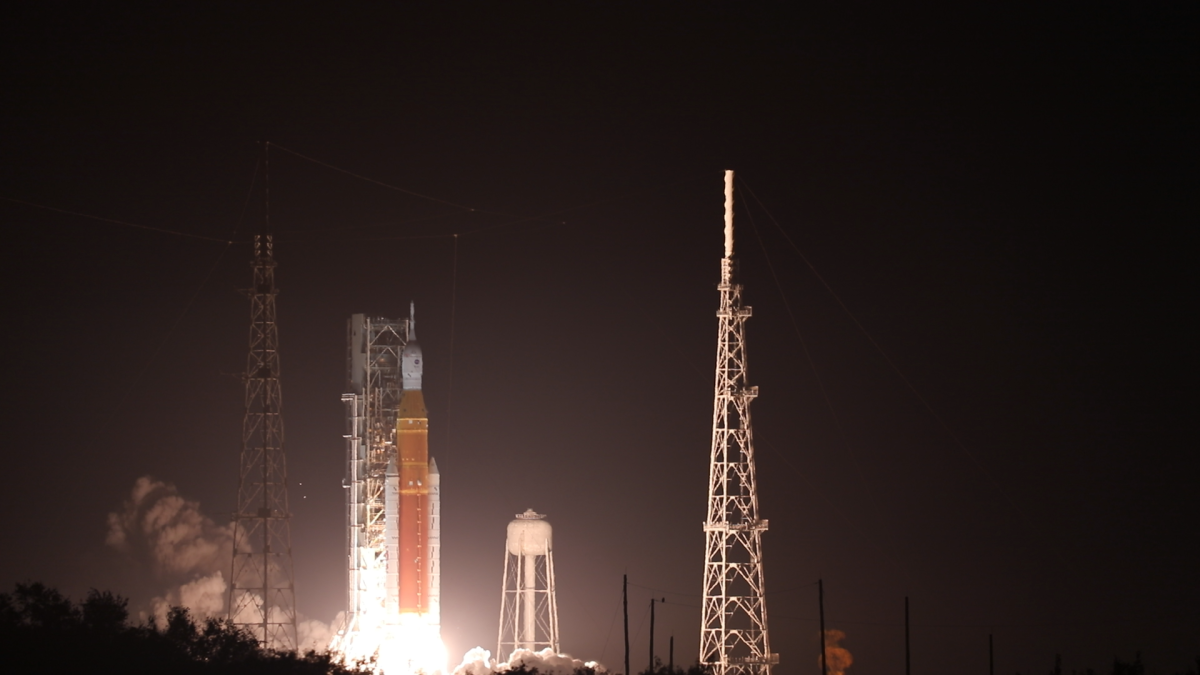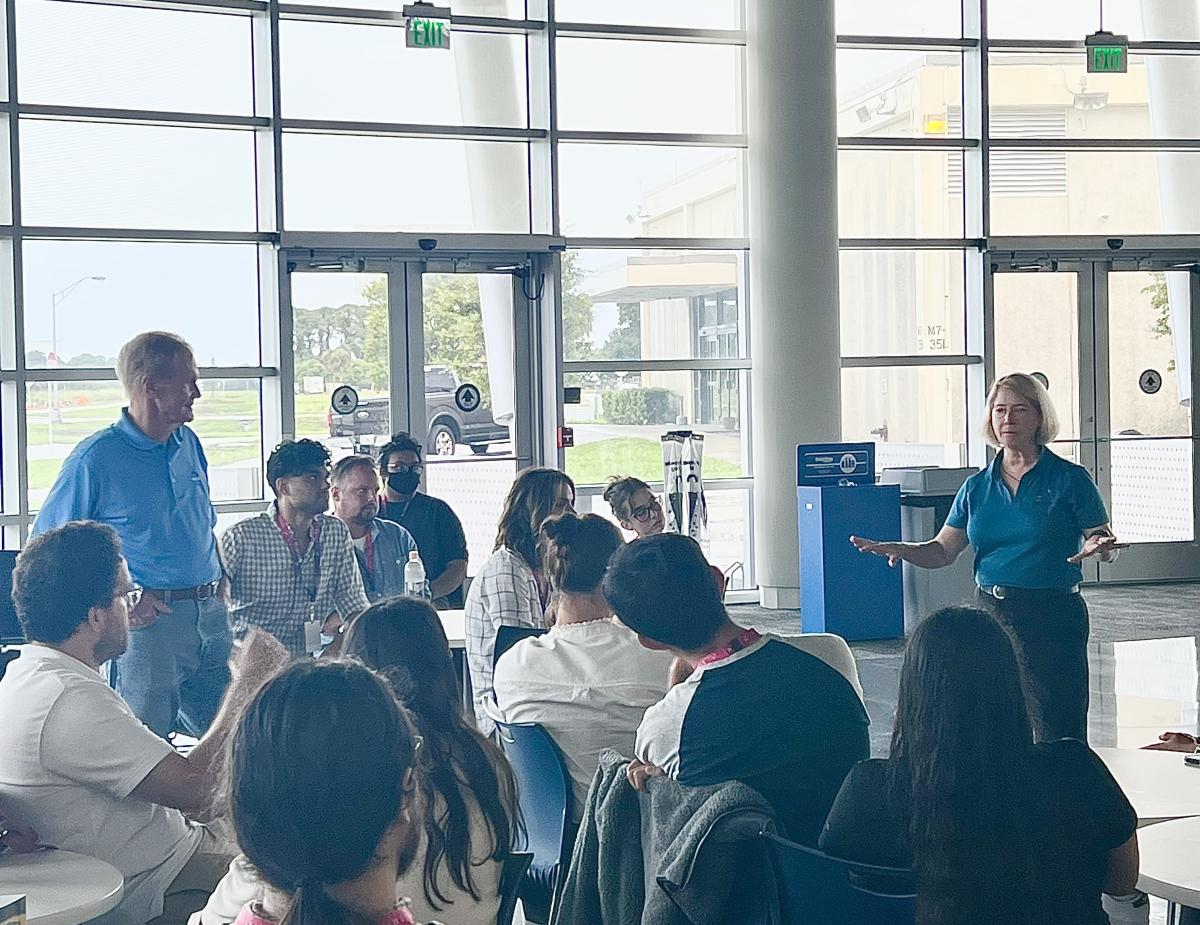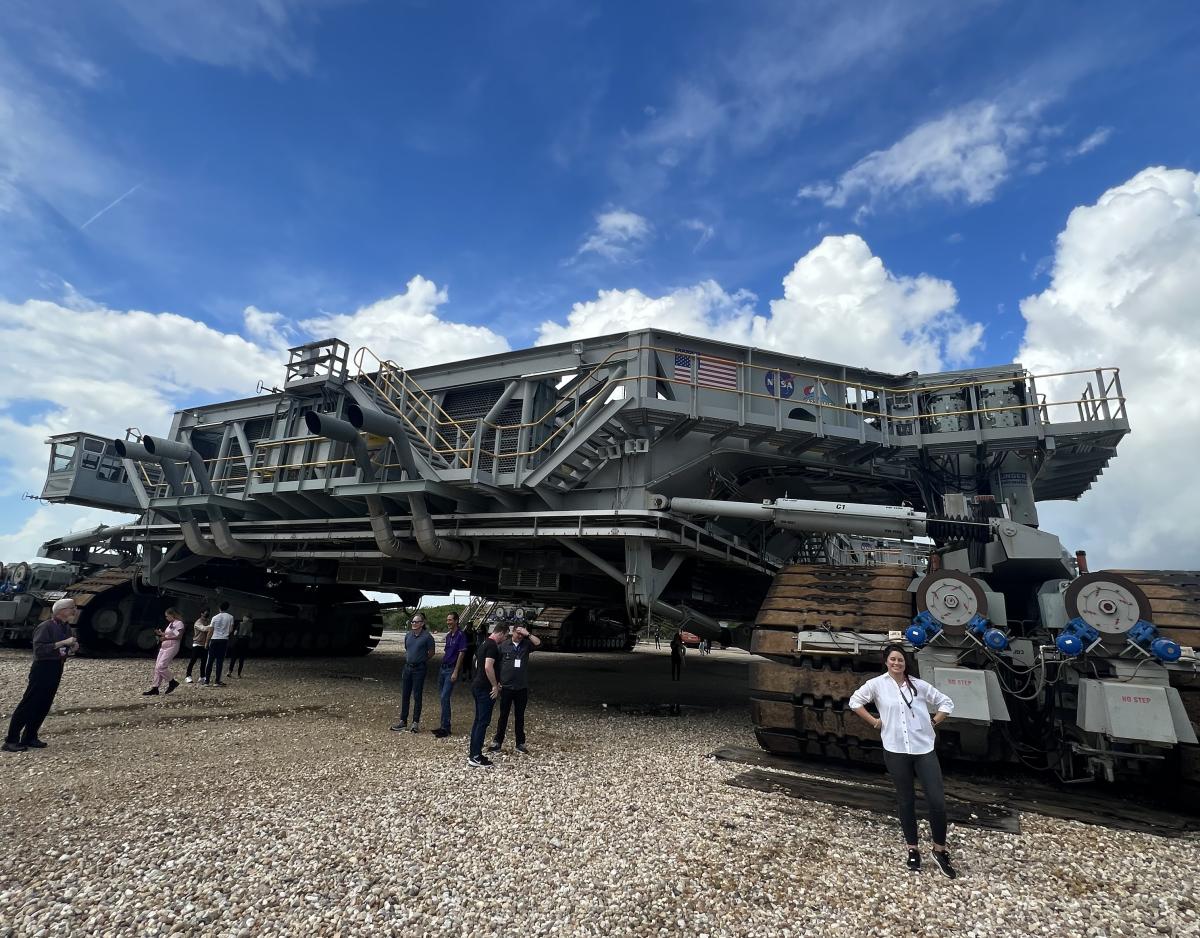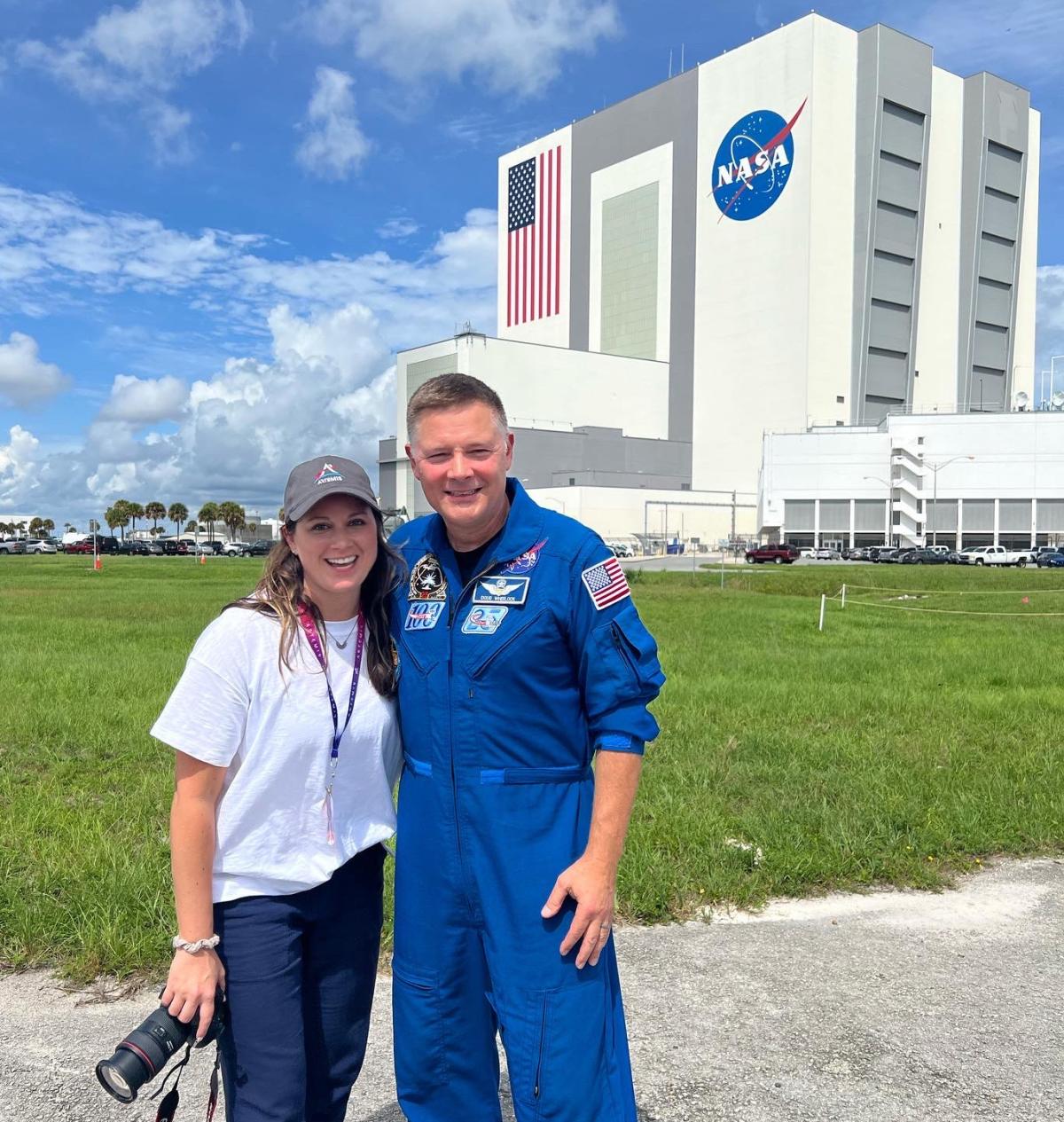AE's Kelsey Gulledge shares her account of the Artemis I launch

Liftoff! Artemis I launched from launchpad 39B on November 16, bringing humanity one step closer to returning to the moon.
After two failed attempts, Artemis I successfully launched from NASA’s Kennedy Space Center (KSC) on November 16, beginning a 25-day mission to the Moon. The Daniel Guggenheim School’s (AE School) communications manager Kelsey Gulledge was on site for the historic launch.
Selected as a NASA Social program attendee, Gulledge was among 100 people from across the globe invited to tour NASA facilities, meet and greet with NASA engineers and scientists, and view the launch of the Space Launch Systems (SLS) Rocket and Orion spacecraft.
In a first-person account, Gulledge chronicles her three visits to the space coast, where she ran into a few Yellow Jackets along the way.
"Hello From NASA!"
This past July, about a month before Artemis’s original August 29 launch, I saw a NASA tweet about a deadline to participate in NASA Social. The program allows participants to come to KSC for a behind-the-scenes look at launches or other newsworthy events.
I thought about applying but went about my day. Then, on the last day they were accepting applications, I quickly submitted, not thinking I’d make the cut. A few days later, I received an email from NASA Headquarters with the subject “Hello from NASA!” I knew that AE School researchers had worked on the propulsion system of one of the mission’s CubeSats - BioSentinel - so I was eager to witness another piece of Tech go to space.

Fellow NASA Social attendee Kate Gunderson (MSAE 2018) and Kelsey Gulledge (right) get a closer look of Artemis.

The NASA Social attendees snagged a photo in front of the official NASA countdown clock with Astro Snoopy.
Failure to Launch
My first trip to “the Cape” began a day prior to the scheduled launch. Day one included tours, meetings, and exclusive access to NASA content. My group included about 100 scientists, engineers, photographers, videographers, communicators, influencers, artists, the Harlem Globetrotters, lovers of space, and everything in between.
Led by the NASA’s social media team, we met with two current NASA astronauts, Jessica Meir and Randy Bresnik, and Canadian astronauts Jeremey Hansen and Joshua Kutryk. We also heard from NASA Administrator Bill Nelson, Deputy Administrator Pam Melroy and Associate Administrator Bob Cabana.
They kept thanking us for being there and sharing the Artemis story, but I was amazed that they took so much time to meet with our group and pose for photos during a very busy and hectic week at NASA. We toured the Vehicle Assembly Building (VAB), the launchpad, and got up close and personal with the crawler that drove SLS between the two locations.
On launch day, we loaded onto our buses at the KSC Visitor Complex at 1:30 a.m. We had a pretty stellar viewpoint. From our vantage point at the VAB, we were just 4.2 miles from launchpad 39B.
The NASA merchandise shop and food trucks kept the social media gurus and reporters occupied and awake as we counted down toward the scheduled 8:22 a.m. launch time. As liftoff neared, we anxiously listened to the reports coming in from mission control — it wasn’t looking good. Although we saw a beautiful sunrise, we would soon learn that the launch was scrubbed due to a hydrogen bleed line with one of the rocket's four core stage engines.
I flew home the next day not sure I’d be able to come back for the second attempt two days later. While waiting for my flight, I asked AE School Chair Mark Costello what he thought about me returning.
“Go for it!” he said. Excited, I quickly booked my travel.

NASA Administrator Bill Nelson and Deputy Administrator Pam Melroy spoke to the NASA Social team
They kept thanking us for being there and sharing the Artemis story, but I was amazed that they took so much time to meet with our group and pose for photos during a very busy and hectic week at NASA. We toured the Vehicle Assembly Building (VAB), the launchpad, and got up close and personal with the crawler that drove SLS between the two locations.
On launch day, we loaded onto our buses at the KSC Visitor Complex at 1:30 a.m. We had a pretty stellar viewpoint. From our vantage point at the VAB, we were just 4.2 miles from launchpad 39B.
The NASA merchandise shop and food trucks kept the social media gurus and reporters occupied and awake as we counted down toward the scheduled 8:22 a.m. launch time.
As liftoff neared, we anxiously listened to the reports coming in from mission control — it wasn’t looking good.

Kelsey Gulledge looks at the sunrise the morning of the scheduled Artemis I launch.
Although we saw a beautiful sunrise, we would soon learn that the launch was scrubbed due to a hydrogen bleed line with one of the rocket's four core stage engines.
I flew home the next day not sure I’d be able to come back for the second attempt two days later. While waiting for my flight, I asked AE School Chair Mark Costello what he thought about me returning.
“Go for it!” he said. Excited, I quickly booked my travel.
Round Two
I arrived back at the Cape on a Friday night, with instructions to report to the NASA press site at 6 a.m. on Saturday. This time launch was scheduled for 2:17 p.m.
After a few hours of sleep, I arrived dark and early, running on caffeine and chasing the dream of seeing SLS fly. Our original group of 100 fell to about 50 due to work obligations, Covid, financial limits, and a slew of other logistic hurdles. For me, it was like going back to adult space camp without the whole crew.
As we waited outside the VAB, we saw the sunrise and were anxiously checking the broadcasts and launch updates. After a few hours, the feeling of another scrub set in because of a leaky fuel line in one of the propellant tanks.
Just after the scrub was announced, astronaut Doug “Wheels” Wheelock a Georgia Tech aerospace engineering alumnus, visited us. Small world! Since it was so hot, he jumped on our bus and shared stories about his journey of becoming an astronaut.
He told us how much watching Neil Armstrong walk on the Moon impacted him as a child, combined with his 4th grade teacher telling him he could one day become an astronaut. Apollo 11 fueled him decades later to pursue his dreams.
Just three days after being selected as a NASA astronaut, he was at a NASA event and ended up sharing a table with Neil. A full circle moment! Doug stood in the hot sun with us and posed for photos and answered even more questions from our group.

Kelsey Gulledge poses with the Crawler-transporter 2 (CT-2) that was responsible for carrying the SLS rocket to and from the launch pad.

Kelsey Gulledge and Doug Wheelock (MSAE 1992) smile outside the iconic NASA Vehicle Assembly Building (VAB).

Doug Wheelock and Christina Koch joined the NASA Social Media group for Q&A before launch.
The countdown stopped at T-10 minutes due to a leak and, yet again, the feeling of another scrub crept into our minds. We were hopeful that things would resume but launching to space is hard and there are so many different variables at play. The red crew members worked courageously to fix the issue and just like that, we heard that the countdown would resume at T-10 minutes.
Everyone was buzzing with excitement as the clock inched past 1:37 a.m. People were running around to check on their cameras, use the bathroom, get a good seat, and make sure no one was asleep on the bus. My heart was racing, and the energy was electric. We were finally going to, as the kids say, “light this candle.”
Moments from history, we were playing the broadcast audio and getting closer to “all systems go.” At T-10 seconds, the group became quiet. Then a voice in the dark shouted “any second now!” And then the thrusters ignited and what could only be described as a second sun was rising right before us. We could feel the heat of the flames as the rocket started to liftoff.
We cheered and screamed and shed a few tears as we watched in amazement. About 18 seconds later, the sound hit us. Doug Bradley was correct: it was a “multi-sense” experience. The rocket gave off a familiar sound of a jet flying overhead, but quickly turned into a rattling sound of firework explosions that somehow grew louder and louder. We could feel the sound. It was easily the loudest thing I’ve ever heard.
Artemis drove further and further away, as did the sound and heat, but everyone still stared. We had finally witnessed the start of the Artemis generation. It was a once in a lifetime experience that I still haven’t been able to fully grasp. The next Artemis missions will include a crew of astronauts including the first woman and person of color who will walk on the moon, and I can’t help but think of the kids who – like Wheels – are now inspired to pursue their dreams.
We are going. And we are going together.